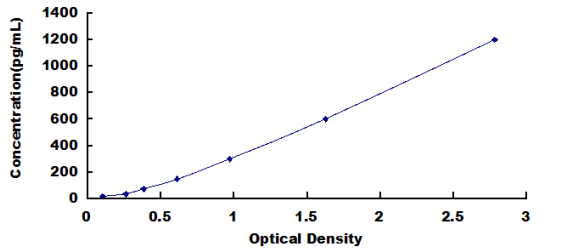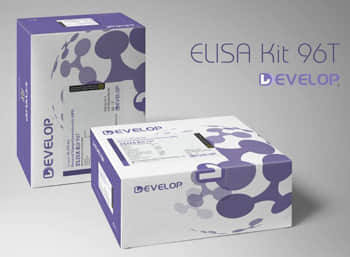Human Angiopoietin 4 (ANGPT4) ELISA Kit


two product lines: Traditional ELISA Kit and Ready-to-Use ELISA Kit.


Other names:ANG4; AGP4; ANG-3
Function: Binds to TEK/TIE2, modulating ANGPT1 signaling. Can induce tyrosine phosphorylation of TEK/TIE2. Promotes endothelial cell survival, migration and angiogenesis.
Sequence:
50 MLSQLAMLQG SLLLVVATMS VAQQTRQEAD RGCETLVVQH GHCSYTFLLP 100 KSEPCPPGPE VSRDSNTLQR ESLANPLHLG KLPTQQVKQL EQALQNNTQW 150 LKKLERAIKT ILRSKLEQVQ QQMAQNQTAP MLELGTSLLN QTTAQIRKLT 200 DMEAQLLNQT SRMDAQMPET FLSTNKLENQ LLLQRQKLQQ LQGQNSALEK 250 RLQALETKQQ EELASILSKK AKLLNTLSRQ SAALTNIERG LRGVRHNSSL 300 LQDQQHSLRQ LLVLLRHLVQ ERANASAPAF IMAGEQVFQD CAEIQRSGAS 350 ASGVYTIQVS NATKPRKVFC DLQSSGGRWT LIQRRENGTV NFQRNWKDYK 400 QGFGDPAGEH WLGNEVVHQL TRRAAYSLRV ELQDWEGHEA YAQYEHFHLG 450 SENQLYRLSV VGYSGSAGRQ SSLVLQNTSF STLDSDNDHC LCKCAQVMSG 500 GWWFDACGLS NLNGVYYHAP DNKYKMDGIR WHYFKGPSYS LRASRMMIRP LDI
INTENDED USE
The kit is a sandwich enzyme immunoassay for the in vitro quantitative measurement of ANGPT4 in human serum, plasma, tissue homogenates or other biological fluids.
DETECTION RANGE
18.75-1200pg/mL. The standard curve concentrations used for the ELISA’s were 1200pg/mL, 600pg/mL, 300pg/mL, 150pg/mL, 75pg/mL, 37.5pg/mL, 18.7pg/mL.
SENSITIVITY
The minimum detectable dose of ANGPT4 is typically less than 7.36pg/mL.
The sensitivity of this assay, or Lower Limit of Detection (LLD) was defined as the lowest protein concentration that could be differentiated from zero. It was determined by adding two standard deviations to the mean optical density value of twenty zero standard replicates and calculating the corresponding concentration.
SPECIFICITY
This assay has high sensitivity and excellent specificity for detection of ANGPT4.
No significant cross-reactivity or interference between ANGPT4 and analogues was observed.
You can reference link of the kit as following
https://dldevelop.com/Research-reagent/dl-angpt4-hu.html
https://www.dldevelop.com/uploadfile/data/DL-ANGPT4-Hu.pdf
Introduction
| Item | Standard | Test | |
| Description |
The kit is a sandwich enzyme immunoassay for the in vitro quantitative measurement of ANGPT4 in human serum, plasma, tissue homogenates and other biological fluids. |
Conform | |
| Identification | Colorimetric | Positive | |
| Composition | Traditional ELISA Kit | Ready-to-Use ELISA KIT | Conform |
| Pre-coated, ready to use 96-well strip plate 1 | Pre-coated, ready to use 96-well strip plate 1 | ||
| Plate sealer for 96 wells 2 | Plate sealer for 96 wells 2 | ||
| Standard 2 | Standard 2 | ||
| Diluents buffer 1×45mL | Standard Diluent 1×20mL | ||
| Detection Reagent A 1×120μL | Detection Solution A 1×12mL | ||
| Detection Reagent B 1×120μL | Detection Solution B 1×12mL | ||
| TMB Substrate 1×9mL | TMB Substrate 1×9mL | ||
| Stop Solution 1×6mL | Stop Solution 1×6mL | ||
| Wash Buffer (30 × concentrate) 1×20mL | Wash Buffer (30 × concentrate) 1×20mL | ||
| Instruction manual 1 | Instruction manual 1 | ||
Test principle
The microtiter plate provided in this kit has been pre-coated with an antibody specific to the index. Standards or samples are then added to the appropriate microtiter plate wells with a biotin-conjugated antibody preparation specific to the index. Next, Avidin conjugated to Horseradish Peroxidase (HRP) is added to each microplate well and incubated. After TMB substrate solution is added, only those wells that contain the index, biotin-conjugated antibody and enzyme-conjugated Avidin will exhibit a change in color. The enzyme-substrate reaction is terminated by the addition of sulphuric acid solution and the color change is measured spectrophotometrically at a wavelength of 450nm ± 10nm. The concentration of the index in the samples is then determined by comparing the O.D. of the samples to the standard curve.
Recovery
Matrices listed below were spiked with certain level of recombinant ANGPT4 and the recovery rates were calculated by comparing the measured value to the expected amount of the index in samples.
| Matrix | Recovery range (%) | Average(%) |
| serum(n=5) | 81-93 | 86 |
| EDTA plasma(n=5) | 80-97 | 88 |
| heparin plasma(n=5) | 90-101 | 95 |
Linearity
The linearity of the kit was assayed by testing samples spiked with appropriate concentration of the index and their serial dilutions. The results were demonstrated by the percentage of calculated concentration to the expected.
| Sample | 1:2 | 1:4 | 1:8 | 1:16 |
| serum(n=5) | 82-96% | 83-98% | 81-99% | 93-101% |
| EDTA plasma(n=5) | 88-101% | 86-95% | 90-102% | 80-93% |
| heparin plasma(n=5) | 80-91% | 82-90% | 95-104% | 79-95% |
Precision
Intra-assay Precision (Precision within an assay): 3 samples with low, middle and high level the index were tested 20 times on one plate, respectively.
Inter-assay Precision (Precision between assays): 3 samples with low, middle and high level the index were tested on 3 different plates, 8 replicates in each plate.
CV(%) = SD/meanX100
Intra-Assay: CV<10%
Inter-Assay: CV<12%
Stability
The stability of ELISA kit is determined by the loss rate of activity. The loss rate of this kit is less than 5% within the expiration date under appropriate storage conditions.
Note:
To minimize unnecessary influences on the performance, operation procedures and lab conditions, especially room temperature, air humidity and incubator temperatures should be strictly regulated. It is also strongly suggested that the whole assay is performed by the same experimenter from the beginning to the end.
Assay procedure summary
1. Prepare all reagents, samples and standards;
2. Add 100µL standard or sample to each well. Incubate 2 hours at 37℃;
3. Aspirate and add 100µL prepared Detection Reagent A. Incubate 1 hour at 37℃;
4. Aspirate and wash 3 times;
5. Add 100µL prepared Detection Reagent B. Incubate 1 hour at 37℃;
6. Aspirate and wash 5 times;
7. Add 90µL Substrate Solution. Incubate 15-25 minutes at 37℃;
8. Add 50µL Stop Solution. Read at 450nm immediately.
Order or get a Quote
We will reply you within 24 hours!














